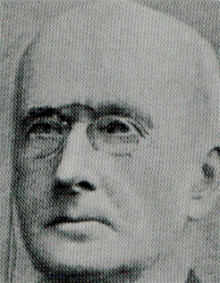
John Jones Bateman was born in Birmingham, Warwickshire England in 1818 [or 1817 - sources differ] and was articled to his father, Joseph Bateman (1778-1857) at his office, Bateman & Drury [George Drury (c,1807-1851)] in Leamington Spa. In 1848 J. J. Bateman was taken into partnership and the practice was renamed Bateman, Drury & Bateman. Joseph Bateman seems to have retired not long afterwards and Drury died in 1851. J. J. Bateman was subsequently in partnership with his former pupil Benjamin Corsar (1840-1918) as Batemen & Corsair from 1862 to 1882, and with his son, Charles Edward Bateman (1863-1947), as Bateman & Bateman in Birmingham from 1887. They were joined by Alfred Hale in 1898.
J. J. Bateman exhibited at the Birmingham Society of Artists in 1834 He was a founder member of the Birmingham Architectural Association and its first President in 1882. He was also a member of the Birmingham Architectural Society. He died in Aston, Warwickshire on 13 June 1903.
Additions to Bromsgrove Union Workhouse (1837) with George Drury; Stratford-upon-Avon Union Workhouse (1837) with George Drury; Leek Union Workhouse (1838) with George Drury; Queen's College, Birmingham (1843), with George Drury; Church of the Saviour, Edward Street and Helena Street, Birmingham (1846), with George Drury; New Birmingham Workhouse Infirmary (1850-52) with George Drury; 13-14 Charlotte Road, Edgbaston for Edward Baker (1851); 105-107 Gough Road, Edgbaston (1851) for Edward and George Baker; Deritend Sunday School, Bull Ring, Birmingham (1853); Bordesley Sunday School, Bordesley, Smithfield Birmingham (1853); House, Soho Hill, Handsworth (1854-55); 11 Ampton Road, Edgbaston (1855) for Robert Gillam; Alterations and extensions to The Priory, King's Heath (1855-56) for John Cartland; Six terraced houses, Ledsam Street, Birmingham (1856); Extension to Deaf and Dumb Institution, Church Road, Edgbaston (1857) with Frederick Fiddian; Shops, workrooms and offices for Hyam & Co., drapers, New Street and Union Street, Birmingham (1857-59); Alterations, restoration and new buildings at Aston Hall, Aston Park (1858); New chapel, Queen's Hospital, Bath Row, Birmingham (1859); Manufactory for John Cartland, brassfounder, Constitution Hill, Birmingham (1859); Workshops and warehouses, Whittall Street, Birmingham (1859); Infirmary for Birmingham Free Industrial School, Gem street, Birmingham (1859-60); Church of the Messiah for the Unitarian Society, Broad Street, Birmingham (1859-62); Museum and Public Lecture Room, Queen's College, Paradise Street, Birmingham (1860-65); Oakfield House, Wellington Road, Edgbaston (1860-67); St. Barnabas National School, Ryland Street, 1861, and additions 1869); Alterations to Birmingham Lying-in Hospital, Broad Street, Birmingham (1862-63); Repairs to Aston Hall, Aston Park, Birmingham (1864-66) for Birmingham Corporation; Deritend Free Library, Heath Mill Lane (1865-66) with Benjamin Corser; Costa Green Free Library, Aston Road and Legge Street, Birmingham (1866-65) with Benjamin Corser; Repairs, alterations and additions to the Gun Barrel Proof House, Banbury Street, Birmingham (1866-76); Corporation Fish Market, Spiceal Street and Bell Street, Birmingham (1869-71) with Benjamin Corser; Manufactory and warehouse for John Stokes, silversmith, 83-84 Great Hampton Street, Hockley (1871) with Benjamin Corser; Alterations to Bingley Hall, Broad Street, Birmingham (1871-73) with Benjamin Cordser; Warehouses, Newhawll Hill, Birmingham (1872-73); Alterations to St. Mary's Church, Whittall Street, Birmingham (1872-73) with Benjamin Corser; Six villas, St. Augustin's Road, Edgbaston (1873) for Edwin Antrobus; St. Philips Buildings, Colmore Row and Church Street, Birmingham (1878) for the Midland Land & Investment Company; Four semi-detached houses in King's Heath -, 255 Vicarage Road, 2 Melstock Road, Birmingham, 1 Melstock Road (1887) for John Cartland; and Newspaper Offices and Print Rooms for The Birmingham Post and Daily Mail, Cannon Street, Birmingham (1894-97) with C. E. Bateman.
Colvin, Howard, A Biographical Dictionary of British Architects 1600-1840. New Haven, Connecticut and London: Yale University Press, 4th edition, 2008
Demidowicz, Toni. ‘John Jones Bateman’ in Birmingham’s Victorian and Edwardian Architects, edited by Phillada Ballard. Wetherby: Oblong Creative Ltd. for the Birmingham and West Midlands Group of the Victorian Society, 2009 pp. 65-88
Directory of British Architects 1834-1914. Compiled by Antonia Brodie, et al. Volume 1: A-K. London; New York: British Architectural Library, Royal Institute of British Architects/Continuum, 2001
'Obituary'. The Builder vol. 84, 1903 p. 663
‘Provincial News: Birmingham’. The Builder vol. 14, 2 August 1856, p. 424 [Report on the new museums at Queen’s College, Birmingham designed by John Jones Bateman]